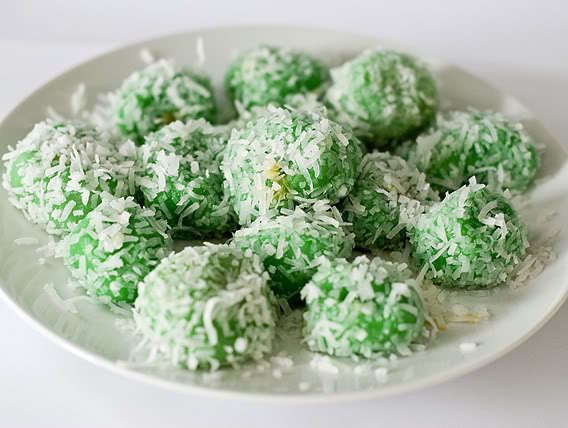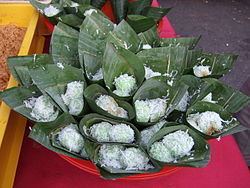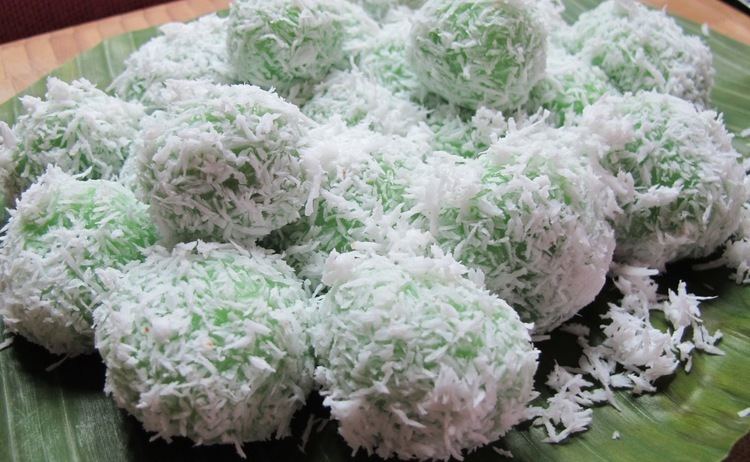Alternative names Onde-onde, Ondeh-ondeh | Type Snack Other information none. | |
Similar Coconut, Jian dui, Palm sugar, Gethuk, Dadar gulung | ||
How to make klepon indonesian sweet snack
Klepon (pronounced Klê-pon) or Onde-onde is a traditional green-coloured balls of rice cake filled with liquid palm sugar and coated in grated coconut. The sweet glutinous rice balls is one of popular Indonesian kue, and it is commonly found in Indonesia, Malaysia, Brunei and Singapore.
Contents
- How to make klepon indonesian sweet snack
- Resep kue klepon indonesian mochi recipe video yuda bustara
- Ingredients and cooking method
- Names
- Variants and similar dish
- References

Resep kue klepon indonesian mochi recipe video yuda bustara
Ingredients and cooking method

It is a boiled rice cake, stuffed with liquid palm sugar (gula jawa/merah/melaka), covered in coconut bits. The dough is made from glutinous rice flour, sometimes mixed with tapioca. It is green because the glutinous rice dough is flavoured and coloured with a paste made from the leaf of pandan or dracaena plant (daun suji) — whose leaves are used widely in Southeast Asian cooking.
The small pieces of palm sugar initially was hard when it was inserted into glutinous rice dough and rolled into balls. The balls then being boiled, subsequently the palm sugar melted due to high temperature, creating a sweet liquid inside the balls' core. The balls then being rolled on grated coconut, thus the coconut bits stick to the sticky balls' surface.
One must be careful on consuming a klepon. Other than the bite could squirted and the ejected liquid palm sugar might stained the shirt, a freshly boiled one — which usually contains hot liquid palm sugar, should be consumed carefully or best to be left to cool down for some moment. Klepon traditionally served in banana leaf container, in traditional marketplaces they are sold in banana leaf package containing four or ten balls. Today however, they might be packed in plastic wrappings.
Names

Klepon is Javanese name for this sweet glutinous rice balls. In other parts of Indonesia, such as in Sulawesi, Sumatra and in neighbouring Malaysia, it is mainly known as onde-onde or in some regions, 'buah melaka' (Malaccan fruit). In Java however, onde-onde refers to the Chinese Jin deui, a rice cake ball coated with sesame seeds and filled with sweet greenbean paste. Although popular across Southeast Asia, klepon may have originated in Java. The dish is also called as klepon in the Netherlands. In the 1950s, klepon was introduced by Indo immigrants to the Netherlands and is readily available in toko shops, Dutch or Chinese Indonesian restaurants and supermarkets throughout the country.

In Java, klepon, along with getuk and cenil, are often eaten as morning or afternoon snacks. They are categorised as kue basah (moist kue), and are part of traditional Javanese jajan pasar (Javanese for "market buys" or "market munchies").
Variants and similar dish
Traditional klepon is quite homogenous in Indonesia and neighbouring Malaysia and Singapore. Nevertheless, new recipes has been developed in the country. Recently several new variants has been created — for example by replacing the rice flour with yam or sweet potato (Indonesian: ubi) dough, or replacing the liquid palm sugar filling with chocolate, or replacing the grated coconut with grated cheddar cheese. Colourful klepon also has been created using potato-based dough and food colouring to make them more appealing for children.
Klepon is quite similar to Kue putu, with the difference in its shape, texture and the flour being used — klepon uses glutinous rice flour, while kue putu uses common rice flour, klepon has somewhat a chewy sticky texture similar to mochi, while kue putu has soft yet crumbly texture akin to common cake. Klepon shape is balls, while kue putu is tubular using hollow bamboo tube as mould.
Recently there is a modern fusion that combine the baking technique of cupcake with onde-onde ingredients.
